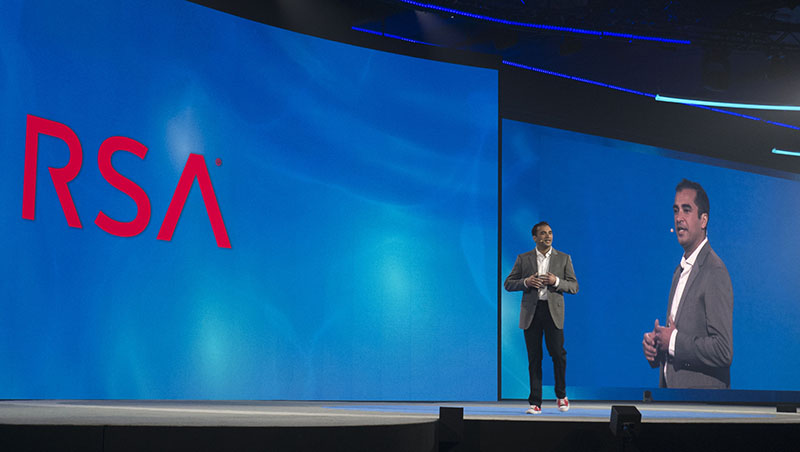C-suite and IT must collaborate for safer businesses
"Business-driven security" is the name of the game at RSA Conference 2017


Security professionals need to come together with business decision makers in order to find solutions that can serve the needs of both. That's according to Zulfikar Razman, CTO of RSA.
In his opening keynote at RSA Conference 2017, Ramzan talked up the need for "business-driven security", which brings the needs of both together through collaboration.
"Security isn't just a technology problem, it's a business problem," Razman told the several thousand delegates in attendance.
"The inability to draw connections between security details and business metrics is what I call the gap of grief. Corporate executives don't care if an incident involved SQL injection or cross-site scripting. They'd like to understand the business implications."
There are three key elements to making business-driven security work, said Razman. First, risk should be treated as a science, not a dark art, using consistent and rigorous methods for analysis. Second, businesses should simplify what they control for example, the number of different security solutions they use.
"I spoke to one chief information security officer recently who has 84 different security vendors. Eighty-four! How do you manage that many vendors? How do you justify to your board and executive suite the return on investment from these vendors? You can't," said Razman, urging companies to only use those that truly bring value to their business.
Finally, organisations must plan for "chaos they can't control", said Ramzan, which means an incident response plan that has the 'ABCs' availability, budget and collaboration.
Sign up today and you will receive a free copy of our Future Focus 2025 report - the leading guidance on AI, cybersecurity and other IT challenges as per 700+ senior executives
On availability, Razman said an incident response plan shouldn't be a wishlist; it needs to be solid. "It sounds obvious, but it's such a common mistake," said Razman, giving the idea of putting "empty fire extinguishers in every hall" as an example of good intentions that will in fact be useless in a real emergency.
Budget, he added, is absolutely vital, because there will be unexpected costs.
"An incident response plan without budget authority is a fairytale," he said.
The final element collaboration is important because every department, from finance to legal to marketing and others all have important roles to play when an incident takes place. Therefore, these teams must be working together beforehand, during the planning phase.
"People will be working 24/7, camping out at the office. That's not the time for introductions," said Razman.
Features editor Jane McCallion is on the ground at RSA Conference 2017 in San Francisco all week. Follow her on Twitter for live updates and bookmark our dedicated page for more coverage from the business security conference.
Image credit: Jane McCallion

Jane McCallion is Managing Editor of ITPro and ChannelPro, specializing in data centers, enterprise IT infrastructure, and cybersecurity. Before becoming Managing Editor, she held the role of Deputy Editor and, prior to that, Features Editor, managing a pool of freelance and internal writers, while continuing to specialize in enterprise IT infrastructure, and business strategy.
Prior to joining ITPro, Jane was a freelance business journalist writing as both Jane McCallion and Jane Bordenave for titles such as European CEO, World Finance, and Business Excellence Magazine.
-
 Lenovo Idea Tab Plus review
Lenovo Idea Tab Plus reviewReviews Low specs and a terrible stylus weigh Lenovo's Idea Tab Plus down – but it has a bright screen and decent battery life
-
 Gender diversity improvements could be the key to tackling the UK's AI skills shortage
Gender diversity improvements could be the key to tackling the UK's AI skills shortageNews Encouraging more women to pursue tech careers could plug huge gaps in the AI workforce
-
 Dell sells RSA security business to private equity firm
Dell sells RSA security business to private equity firmNews Cash deal worth £1.6bn expected to close within the next 9 months
-
 View from the Airport: RSA Conference 2017
View from the Airport: RSA Conference 2017Opinion Brace yourselves for the cyberpocalypse... or not
-
 Why complex security plans mar business-IT relationship
Why complex security plans mar business-IT relationshipNews Michael Dell talks security at first post-acquisition RSA Conference
-
 What to expect from RSA Conference 2017
What to expect from RSA Conference 2017Opinion This year's security landscape means there's more to discuss than ever
-
 RSA 2016: Weakened encryption compromises national security
RSA 2016: Weakened encryption compromises national securityNews Terrorists will move to other platforms, while criminals will exploit the flaws, claim speakers
-
 ChewBacca malware steals data from retailers in 11 countries
ChewBacca malware steals data from retailers in 11 countriesNews RSA researchers uncover global malware operation that relies on ChewBacca keystroke logger.
-
 EMC World 2013: Enterprise on back foot with cloud and mobile security
EMC World 2013: Enterprise on back foot with cloud and mobile securityNews RSA chairman paints bleak picture of enterprise threat response.
-
 RSA Europe: Privacy is stunting security says Coviello
RSA Europe: Privacy is stunting security says CovielloNews New cybersecurity methods and models needed to combat threats, says RSA chairman.